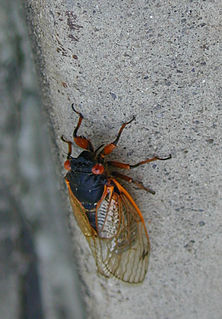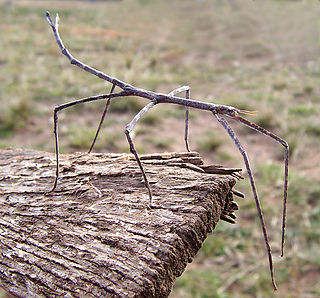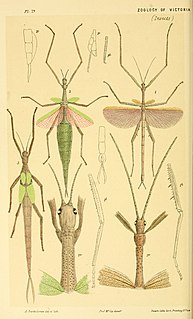External links
| General | |
|---|---|
| National libraries | |
| | This Phasmatodea related article is a stub. You can help Wikipedia by expanding it. |
The Phasmid Study Group is a group for professional and amateur entomologists who are interested in the order Phasmatodea, i.e. stick and leaf insects, known as "phasmids", as well as other interested persons. Over 40 species of Phasmid have been named after members of the group.[ citation needed ] The group includes world experts in the study of phasmids worldwide.
The group was formed in 1980 and has since developed a worldwide membership. It has meetings twice a year at The Natural History Museum, London. It also distributes phasmids, free of charge, to its members.
The group has two publications. Phasmid Studies is issued occasionally and contains scientific papers and longer articles. The Phasmid Study Group's Newsletter is posted to each member twice a year, it contains shorter articles and announcements, and is printed in full colour with many photographs and much information on phasmids.
The Watchtower Announcing Jehovah's Kingdom is an illustrated religious magazine, published monthly by the Watch Tower Bible and Tract Society of Pennsylvania. Jehovah's Witnesses distribute The Watchtower—Public Edition, along with its companion magazine, Awake!.

The Phasmatodea are an order of insects whose members are variously known as stick insects, stick-bugs, walking sticks, or bug sticks. They are generally referred to as phasmatodeans, phasmids, or ghost insects. Phasmids in the family Phylliidae are called leaf insects, leaf-bugs, walking leaves, or bug leaves. The group's name is derived from the Ancient Greek φάσμα phasma, meaning an apparition or phantom, referring to their resemblance to vegetation while in fact being animals. Their natural camouflage makes them difficult for predators to detect; still, many species have one of several secondary lines of defence in the form of startle displays, spines or toxic secretions. Stick insects from the genera Phryganistria, Ctenomorpha, and Phobaeticus includes the world's longest insects.

The Society of Economic Geologists (SEG) is a scientific organization that promotes the study of geology as it relates to mining, mineral exploration, mineral resource classification and mineral extraction. The society's Publication Board publishes the scientific journal Economic Geology. The society serves 7,000+ members worldwide who are committed to advancing the science and the discovery of mineral resources through research, publications, courses, and field trips.
The Association of Teachers of Japanese (ATJ) is "an international, non-profit, non-political organization of scholars, teachers, and students of Japanese language, literature, and linguistics dedicated to teaching and scholarship and to the exchange of information among teachers and other professionals to help broaden and deepen knowledge and appreciation of Japan and its culture." It is based out of the University of Colorado in the United States.

Cicadomorpha is an infraorder of the insect order Hemiptera which contains the cicadas, leafhoppers, treehoppers, and spittlebugs. There are approximately 35,000 described species worldwide. Distributed worldwide, all members of this group are plant-feeders, and many produce either audible sounds or substrate vibrations as a form of communication. The earliest fossils of cicadomorphs first appear during the Late Permian.
Labour/Le Travail is an academic journal which publishes articles on the labour movement in the Canada, sociology, labour economics, and employment relations. Although its focus is Canadian, the journal carries articles about the United States and other nations as well.

Extatosoma is a genus of phasmids, in the monotypic subfamily Extatosomatinae, with two species. One occurs in Australia, one in New Guinea. Both have a colour morph imitating leaves, and one imitating lichen.

The Euphasmatodea, also known by its junior synonym Verophasmatodea is a suborder of the Phasmatodea, which contains the vast majority of the extant species of stick and leaf insects.

The Phasmatidae are a family of the stick insects. They belong to the superfamily Anareolatae of suborder Verophasmatodea.

Megacrania batesii, commonly known as the peppermint stick insect, is an unusual species of stick insect found in northeastern Australia, the Bismarck Archipelago, the Solomon Islands, New Guinea, and possibly as far north as the Philippines. It is notable for its aposematic coloration, as well as its robust chemical defense mechanism. Its common name refers to the irritating fluid — with an odor resembling peppermint — that it sprays as a defensive action from a pair of glands located at its prothorax when threatened, as well as the cylindrical, twig-like shape of its body. A member of the subfamily Megacraniinae, it was first described by English naturalist and explorer Henry Walter Bates in 1865.
The Group Analytic Society International was founded in London in 1952 by S. H. Foulkes, Jane Abercrombie and Norbert Elias as a learned society to study and promote the development of Group Analysis in both its clinical and applied aspects. The first regular weekly seminars were given by Foulkes in 1952. Members of the Society come from different countries and from many fields and disciplines, including psychology, sociology, medicine, nursing, social work, counselling, education, industry, architecture, anthropology and theology.

The Phasmatinae are a subfamily of stick insects in the family Phasmatidae. They contain at least three tribes; Bradley and Galil corrected the spelling to "Phasmatinae" and provides a key to tribes.

Diapheromeridae is a family of stick insects. They belong to the superfamily Anareolatae of suborder Verophasmatodea.

Peruphasma schultei is a species of stick insect found in the Cordillera del Condor region of northern Peru. In the wild the insect feeds on Schinus plants, but will feed on privet, Aucuba japonica and honeysuckle in captivity. In Peru they are only known to exist in a region of less than 5 hectares, but since their discovery they have become increasingly popular as pets worldwide due to their unusual colouration and they are now bred regularly in captivity.

Didymuria violescens, the spur legged phasmid, also known as the Violet-winged stick insect, or Violet-winged phasma, is a common phasmid native to Australia.

Eurycnema goliath, commonly known as the goliath stick insect, or the regal stick insect, is a large species of stick insect in the family Phasmatidae, endemic to Australia and considered one of the largest species of stick insects in the country. The species has the Phasmid Study Group number PSG14.

Palophinae is a subfamily of the stick insect family Diapheromeridae. They belong to the superfamily Anareolatae of suborder Verophasmatodea.
The Concrete Society is a UK based non-profit company that was founded in 1966 in response to the increasing need for a single organisation embracing all those interested in concrete. On its formal inauguration, on 13 October 1966, the Society took over the work of the four organisations, by then in the process of dissolution, in order both to carry on their work and to extend it to cover the entire field of concrete technology and use.
Judith A. Marshall is an entomologist in the UK, she is an expert in grasshoppers, crickets and related insects (Orthoptera) and is emeritus Curator of Entomology at the Natural History Museum, London.